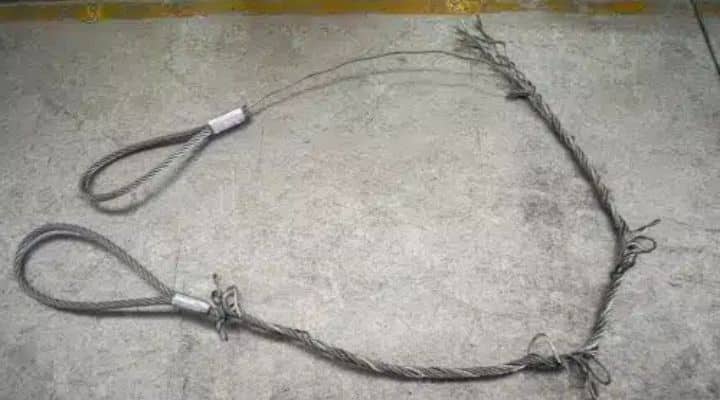The overhead crane industry is rightfully concerned about the failure of wire rope and has a profound and obvious interest in preventing it. Depending upon which expert you talk with, there are many opinions as to the ‘main causes’ of these failures.
The list for reasons leading to the failure of wire rope is lengthy, and every reason is worthy of consideration. After all, everything comes down to safety.
With that in mind, we’re going to boil this down and simplify things, and we’re going to do that by making a statement and then drawing two conclusions. At least to begin with.

First, a wire rope is a machine.
A wire rope is a machine, by dictionary definition: “An assemblage of parts… that transmit forces, motion, and energy one to another in some predetermined manner and to some desired end.”
A typical wire rope may contain hundreds of individual wires which are formed and fabricated to operate at close bearing tolerances one to another. When a wire rope bends, each of its many wires slides and adjusts in the bend to accommodate the difference in length between the inside and the outside bend. The sharper bend, the greater movement.
Intellectually, while we may understand and agree with the premise, it’s awkward to think of rope as some kind of a ‘real’ machine. We expect to thoroughly and routinely maintain our very expensive equipment. We understand that real equipment undergoes hard use and we have to pay attention to it. But… pay attention to a rope? In an environment with larger machines wire ropes are often overlooked, and ignoring them leads to serious problems. This leads right in to the real culprits and causes of failure.
According to the Access Engineering Library, the cause for steel rope failures lies at the feet of human nature, which is to say, neglect and abuse.
Neglect and abuse are the two chief enemies of wire rope life. One costly form of neglect is lack of proper field lubrication. Abuse takes many forms: improper reeling or unreeling, wrong size or worn sheaves, improper storage, bad splicing are a few. More can be cited, but these two are the main culprits.
Now, with this understanding in mind, we can properly consider a comprehensive list of other contributing factors. At least we are on the same page. As the famous cartoonist, Walt Kelly, once wrote in the strip, Pogo: “We have met the enemy and he is us!” All that having been said, let’s have a look around.
What will cause a wire rope to break?
§ Wear in sections where hoist drums and sheave contact rope
§ A lack of lubrication for extended periods
§ Prolonged exposure to heat and moisture
§ Constantly repeated bending— fatigue can happen during normal operating conditions
§ Consistently neglecting manufacturers’ weight charts—overloading systems is the most common cause of breaks
§ Crushing, dragging, or cutting rope because of mechanical abuse
§ Spooling onto multi-layered drums causes crushing
§ Using frozen or stiff ropes
§ Improper installation will cause kinks
The problems listed above can mostly be avoided if operators practice proper rope maintenance procedures. Some issues cannot be avoided, and so frequent inspections must be done to ensure users can know the full extent of their rope’s health.
Some wire rope users believe in a statutory life policy, which states that ropes be retired at predetermined times. Others go by a retirement clause, which allows cables to be used until deteriorated beyond a set point. Although some still practice statutory policies, regulators claim this policy is overly wasteful compared to the retirement clause.
Do not wait for your next accident. Be proactive with the health of your wire rope. Make sure to properly use ropes, meaning acquiring necessary rigging supplies, like nylon slings or wire rope slings. It is imperative you monitor your wire ropes and that they get retired before a problem or accident occurs. Relying upon outside experts will help.
Wire Rope Safety: Corrosion, Fatigue and Abrasion
Corrosion Breaks
Corrosion issues in wire ropes are one of the most difficult causes of wire rope damage and failures to identify, which is why it is one of the most dangerous. Wire rope failures due to corrosion are typically the result of poor lubrication. You can measure some amount of the lubrication by looking at the pitted surface of every individual rope, but this tells us little of the damage done to the core. Since it is difficult to identify the full spectrum of corrosion, this break stands apart as mysterious and deadly.
It is also often caused by poorly grooved drums and sheaves. You know the wire ropes have experienced abrasions when the wire ends are worn thin. Expert inspection can pinpoint this.
Fatigue-Caused Failure
When hoist ropes go through repetitive bending over sheaves, cracks will eventually develop in the individual wires. Sections of the wire that move over the sheaves develop the worst fatigue. The damage can often be seen by the naked eye. Whenever one broken wire appears due to fatigue, more will follow. Since these issues are essentially the result of wear and tear on the rope wire, they are considered a normal part of operating a crane.
Being fluent in safety measures is just as valuable to an employer as competency with cable rigging hardware. People who know how to spot areas for potential failures can keep themselves and their coworkers secure, which saves time, money, and even lives.
Abrasion-Caused Failure
Abrasion-caused failure occurs when the wire rope has been damaged by irregular contact with hoist sheaves and drums or when it awkwardly rubs against an object such as shelving or a crane girder.
Abrasion wire breaks of hoist wire ropes are located at points where the rope has been damaged by improper contact with hoist sheaves and drums or has struck an external object such as the crane girder or shelving. Improperly grooved sheaves and drums or improper fleet angle into the sheaves can often cause this kind of damage. Wire breaks caused by abrasion show broken wire ends worn to knife-edge thinness
This article is concerned with safety and gives a dozen considerations to improve safety in your factories and job sites. It does boil down to three key points:
- Always remember that your wire rope is a machine unto itself, and thus deserves and requires vigilance in its maintenance.
- Neglect is often a determining factor in wire rope failures, followed by, in close order.
- Abuse of machinery. Ignorance, neglect and abuse are all related when it comes to machine failure.
The 9-plus other factors, once you study them, are all derived from operator and owner abuse of the overhead crane machinery, along with neglect of the proper maintenance due the expensive equipment companies rely upon for producing goods and services critical to their bottom line.
A proper inspection and maintenance program will go a long way toward improving plant safety. CraneTech can help you establish one which will meet or exceed all national and state guidelines and requirements.




